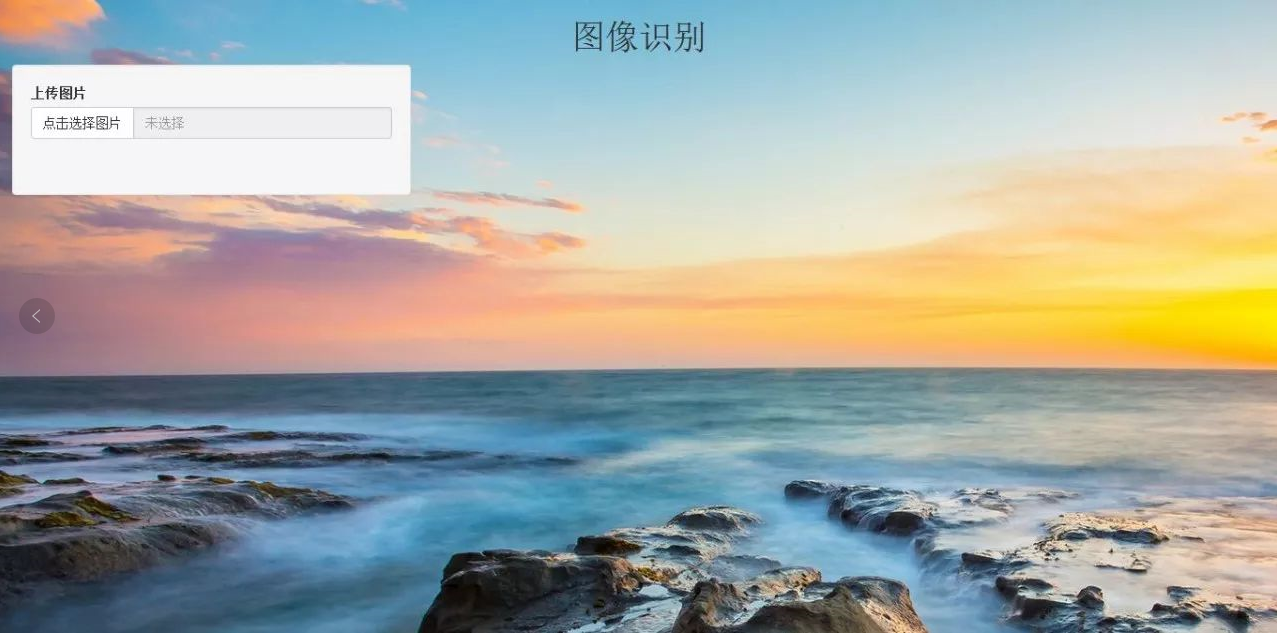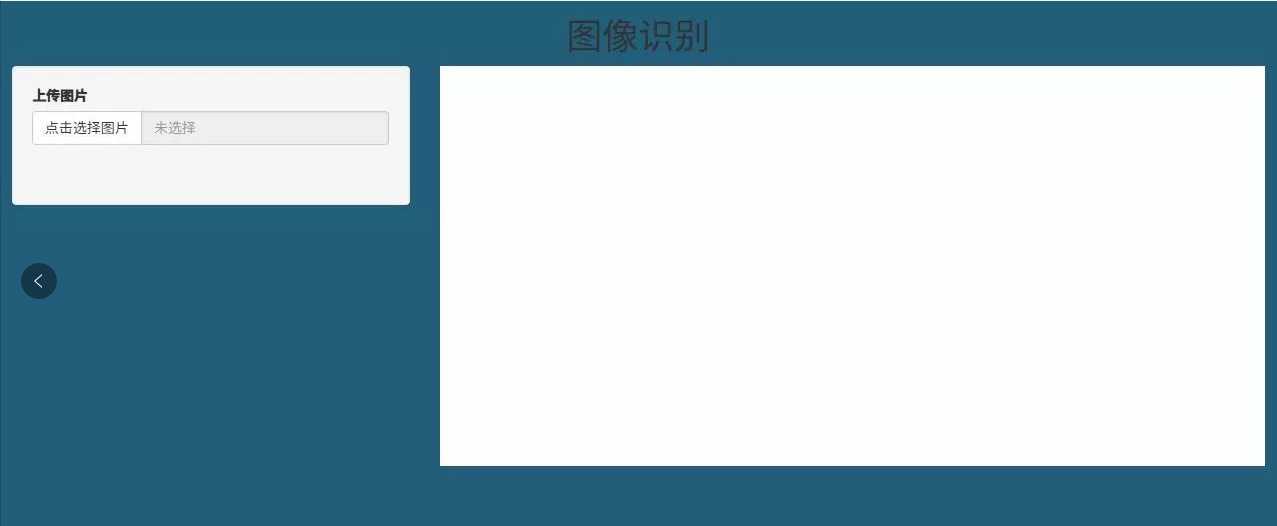搭建一款属于你自己的图像识别系统
2018-03-02 18:25
260 查看
上一篇文章是一篇关于使用TensorFlow和R语言的一个图像识别,今天就用shiny将它包装成一个小程序。shiny程序分为两个部分,一个是ui.R,一个是server.R。ui.R实现的是前端,server.R实现的是服务器端。
我的ui.R是在Windows系统上面写的,准备在写server.R的时候再在Linux上面写,因为总感觉在Windows下方便许多。为了使界面更加美观,我在ui.R里面也加了一点点的CSS,效果如下,感觉界面也差不多。

结果在Linux系统不知道怎么回事,CSS上面的背景图片加载不上了,底色也全是白色的,所以只能换成把背景改成单一色。

首先来大概演示一下效果,点击左边的点击选择图片,就会出现一个对话框再选择一张照片。这里我选择一张香蕉的照片来演示一下。这里识别时间多则20来秒,少则7,8秒。

运行结果如下图:

使用shiny可以使用很少代码做出一个非常棒的web项目。首先跟大家分享一下ui.R。1. ui.R
我的ui.R是在Windows系统上面写的,准备在写server.R的时候再在Linux上面写,因为总感觉在Windows下方便许多。为了使界面更加美观,我在ui.R里面也加了一点点的CSS,效果如下,感觉界面也差不多。

结果在Linux系统不知道怎么回事,CSS上面的背景图片加载不上了,底色也全是白色的,所以只能换成把背景改成单一色。

首先来大概演示一下效果,点击左边的点击选择图片,就会出现一个对话框再选择一张照片。这里我选择一张香蕉的照片来演示一下。这里识别时间多则20来秒,少则7,8秒。

运行结果如下图:

使用shiny可以使用很少代码做出一个非常棒的web项目。首先跟大家分享一下ui.R。1. ui.R
library(shiny)# Define UI for application that draws a histogramshinyUI(
fluidPage(
includeCSS("style.css"), # Application title
div(style="text-align:center",headerPanel("图像识别")), # Sidebar with a slider input for number of bins
sidebarLayout(
sidebarPanel(
fileInput("image",label="上传图片",accept=c(".png",".jpg"),buttonLabel="点击选择图片", placeholder ="未选择")
), # Show a plot of the generated distribution
mainPanel(
plotOutput("distPlot")
)
)
)
)2. Linux系统css代码<head>
<style>
h{}
body{
background-color: #225E79;
}
</style>
</head>3. Windows系统css代码<head>
<style>
h1 {
}
body {
background-image: url(back.jpg);
background-size: 100% 100% auto;
position:absolute;
background-repeat: no-repeat;
}
</style>
</head>back.jpg就是背景图片。4. server.R#
# This is the server logic of a Shiny web application. You can run the
# application by clicking 'Run App' above.
#
# Find out more about building applications with Shiny here:
#
# http://shiny.rstudio.com/
#
library(shiny)
library(tensorflow) #加载TensorFlow包
library(magrittr) #数据处理包,可以使用管道函数
library(jpeg)
library(readr)
library(ggplot2)
library(grid) #图片处理的一个包,主要控制输出图形的大的外观和一些细节东西的排列
names = read_delim("imagenet_classes.txt", "\t", escape_double = FALSE, trim_ws = TRUE,col_names = FALSE)
slim= tf$contrib$slim #slim是一个使构建,训练,评估神经网络变得简单的库。
# slim提供了很多计算机视觉方面的著名模型(VGG, AlexNet等),我们不仅可以直接使用,甚至能以各种方式进行扩展。
shinyServer(
function(input, output) {
output$distPlot<-renderPlot(
{
inImages<-input$image
if(is.null(inImages))
return(NULL)
tf$reset_default_graph() #在每次运行中清除当前图形,以避免变量重复
#Session会话 张量的具体值和操作,会话关闭时,张量的任何具体值都会丢失
images = tf$placeholder(tf$float32, shape(NULL, NULL, NULL, 3))# 创建占位符
imgs_scaled = tf$image$resize_images(images, shape(224,224)) #设置图片大小
# slim$conv2d自带卷积功能+激励函数
fc8 = slim$conv2d(imgs_scaled, 64, shape(3,3), scope='vgg_16/conv1/conv1_1') %>%
slim$conv2d(64, shape(3,3), scope='vgg_16/conv1/conv1_2') %>%
slim$max_pool2d( shape(2, 2), scope='vgg_16/pool1') %>% #池化操作
slim$conv2d(128, shape(3,3), scope='vgg_16/conv2/conv2_1') %>%
slim$conv2d(128, shape(3,3), scope='vgg_16/conv2/conv2_2') %>%
slim$max_pool2d( shape(2, 2), scope='vgg_16/pool2') %>%
slim$conv2d(256, shape(3,3), scope='vgg_16/conv3/conv3_1') %>%
slim$conv2d(256, shape(3,3), scope='vgg_16/conv3/conv3_2') %>%
slim$conv2d(256, shape(3,3), scope='vgg_16/conv3/conv3_3') %>%
slim$max_pool2d(shape(2, 2), scope='vgg_16/pool3') %>%
slim$conv2d(512, shape(3,3), scope='vgg_16/conv4/conv4_1') %>%
slim$conv2d(512, shape(3,3), scope='vgg_16/conv4/conv4_2') %>%
slim$conv2d(512, shape(3,3), scope='vgg_16/conv4/conv4_3') %>%
slim$max_pool2d(shape(2, 2), scope='vgg_16/pool4') %>%
slim$conv2d(512, shape(3,3), scope='vgg_16/conv5/conv5_1') %>%
slim$conv2d(512, shape(3,3), scope='vgg_16/conv5/conv5_2') %>%
slim$conv2d(512, shape(3,3), scope='vgg_16/conv5/conv5_3') %>%
slim$max_pool2d(shape(2, 2), scope='vgg_16/pool5') %>%
slim$conv2d(4096, shape(7, 7), padding='VALID', scope='vgg_16/fc6') %>%
slim$conv2d(4096, shape(1, 1), scope='vgg_16/fc7') %>%
# Setting the activation_fn=NULL does not work, so we get a ReLU
slim$conv2d(1000, shape(1, 1), scope='vgg_16/fc8') %>%
tf$squeeze(shape(1, 2), name='vgg_16/fc8/squeezed')
tf$summary$FileWriter('/tmp/dumm/vgg16', tf$get_default_graph())$close() #保存在/tmp/dumm/vgg16目录下
restorer = tf$train$Saver()#创建一个Saver 来管理模型中的所有变量。
sess = tf$Session()
restorer$restore(sess, 'vgg_16.ckpt')#复原模型
img1<-readJPEG(inImages$datapath)
d=dim(img1) #获取img1的维度
imgs =array(255*img1,dim = c(1,d[1],d[2],d[3]))
fc8_vals=sess$run(fc8,dict(images=imgs))
fc8_vals[1:5]
probs=exp(fc8_vals)/sum(exp(fc8_vals))
idx=sort.int(fc8_vals,index.return = TRUE,decreasing = TRUE)$ix[1:5]
g = rasterGrob(img1, interpolate=TRUE) #图形进行栅格化
text = ""
for (id in idx) {
text = paste0(text, names[id,][[1]], " ", round(probs[id],5), "\n")
}
#annotate 添加文本注释
#annotation_custom 可以添加各种图形元素到ggplot图中
ggplot(data.frame(d=1:3)) + annotation_custom(g) +
annotate('text',x=0.05,y=0.05,label=text, size=7, hjust = 0, vjust=0, color='blue') + xlim(0,1) + ylim(0,1)
}
)
})使用shiny就这么简简单单的搭建一个系统处理,如果对网页编程懂的话还可以把界面做的更炫一些。转载请注明:作者:王亨公众号:跟着菜鸟一起学R语言原文链接:http://blog.csdn.net/wzgl__wh
相关文章推荐
- 搭建属于你自己的RAMOS系统 – WIN7+VHD+GURB map方式
- 机器学习零基础?手把手教你用TensorFlow搭建图像识别系统
- 机器学习零基础?手把手教你用TensorFlow搭建图像识别系统
- 机器学习零基础?手把手教你用TensorFlow搭建图像识别系统(一)| 干货
- 从原理到代码:大牛教你如何用 TensorFlow 亲手搭建一套图像识别模块 | AI 研习社
- 系统学习数字图像处理之目标识别
- Android 平台 tess-two 图像识别 环境搭建
- 应用HTK搭建语音拨号系统4: 识别器评估
- kaldi 在线中文识别系统搭建
- 从原理到代码:大牛教你如何用 TensorFlow 亲手搭建一套图像识别模块
- Android-图像识别项目OpenCV(1):技术选型以及NDK搭建
- Google工程师:教你用树莓派+Arduino+TensorFlow搭建图像识别小车
- 从原理到代码:大牛教你如何用 TensorFlow 亲手搭建一套图像识别模块
- Android-图像识别项目OpenCV(1):技术选型以及NDK搭建
- 怎么搭建一款合同管理系统
- Appium+Opencv 图像识别在自动化中的使用1-环境搭建
- 手写数字识别系统之图像分割
- Android网络编程之搭建一个属于你自己的简单servlet服务端。
- 基于motion视频捕捉软件的树莓派视频拍照系统(图像变化识别+拍照+邮件)
